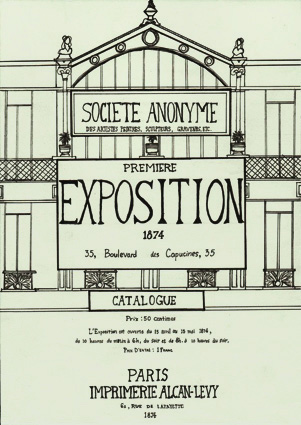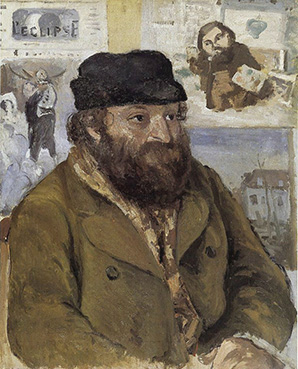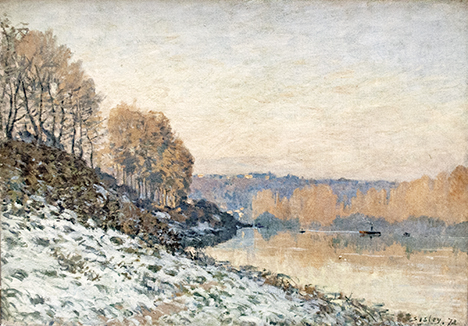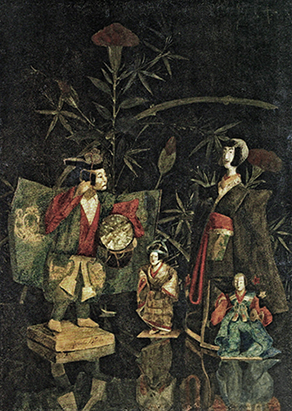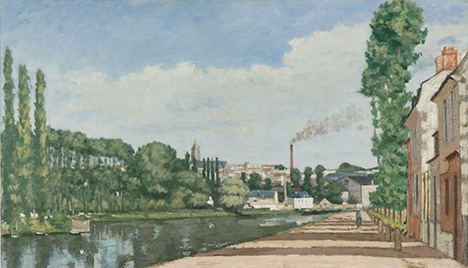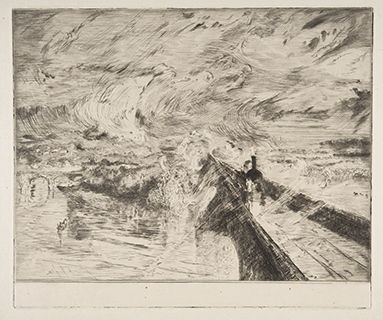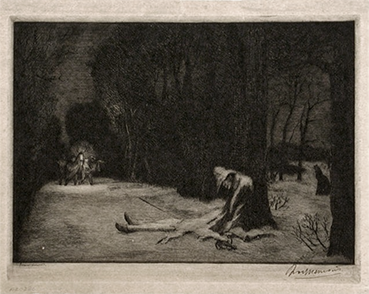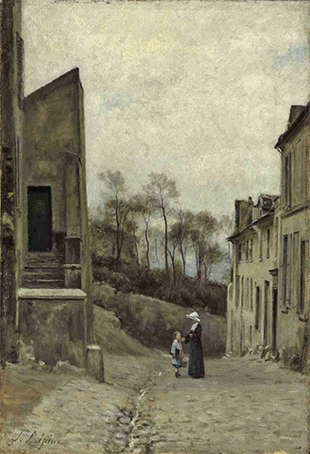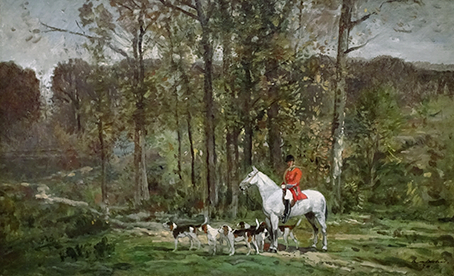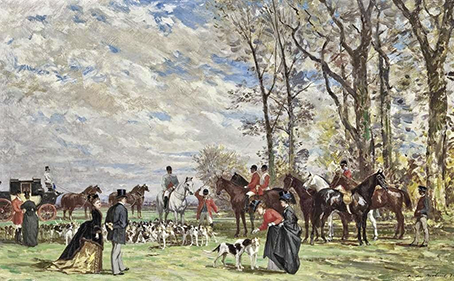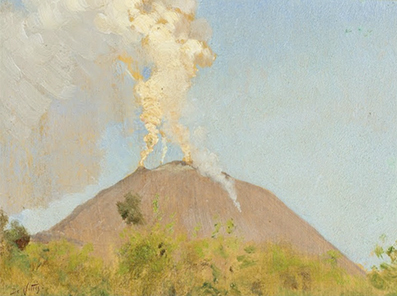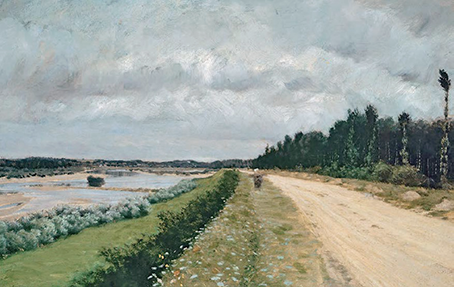
Home |
||
|---|---|---|
Before the exhibitions |
Eight Impressionism exhibitions |
After the exhibitions |
|
||
»Société Anonyme des artistes, peintres, sculpteurs, graveurs, etc –
Première Exposition«
1874 - Paris
First Impressionist exhibition
in Paris in 1874
15 April - 15 May 1874
Boulevard des Capuzines 35 (In the house of the studio of the photographer Nadar)
165 works in the catalogue (3 out of catalogue) - 30 artists
In 1873, Claude Monet took up an idea from 1867: Together with Bazille, he planned his own, self-financed exhibition in a group at the time. The reason for this was probably the realisation that, from his point of view, the re-established "Salon of the Reformed" did nothing to change the established, encrusted system of backward-looking art of the old painting barons.
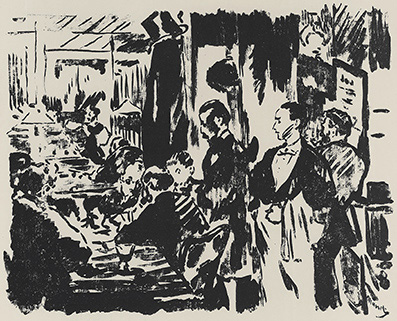
Edouard Manet - Café Guerbois
1869 - 27 × 35,3 cm - Lithography
As so often, they met at the Café Guerbois, where they agreed to form a kind of association to organise independent exhibitions. Paul Alexis (a journalist who also frequented the Café Guerbois and was very fond of the painters) wrote in a Parisian newspaper: "These painters, almost all of whom have already exhibited, belong to a group of naturalists who have the healthy ambition to paint nature and life in their all-encompassing reality." (Pierre Alexis in L'Avenir National on 12 May 1873). Here the painters are still referred to as "naturalists". Alongside Monet, the following were named: Pissarro, Jongkind, Sisley, Béliard, Gautier and Guillaumin. There were also opposing voices who said that only the official Salon was the right way to go. These included Eduard Manet, and Degas was also rather sceptical.
An agreement was finally reached and the association was founded on 27 December 1873. The founding members included: Claude Monet, Pierre-Auguste Renoir, Alfred Sisley, Edgar Degas, Berthe Morisot, Camille Pissarro and, among others, Edouard Béliard, Armand Guillaumin and Henri Rouart.
The next step was to find suitable premises, which soon presented themselves in the studio of photographer Nadar. Rooms on the second floor of a corner building on the Boulevard de Capucines. Nadar did not want any money for the use of the rooms, which could be reached directly from the boulevard via a separate staircase.
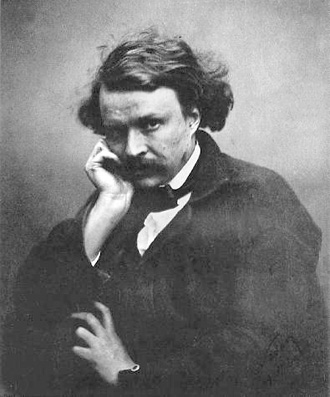
The photographer Nadar (ca. 1870) - Self-portrait

Atelier Nadar on the Boulevard de Capucines
Other artists were sought in order to keep the costs down. With some effort, Pissarro was able to persuade Cézanne. Of the older generation, only Eugène Boudin joined in. Johan Jongkind could no longer be persuaded, while Felix Braquemond agreed at the last moment.
Édouard Manet refused to take part because he did not want to exhibit with Cézanne, and Henri Fantin-Latour also refused to exhibit with his former friends.A considerable number of artists then took part in the 1874 exhibition: Zacharie Astruc, Antoine Attendu, Edmond-Joseph Béliard, Eugène Boudin, Félix Bracquemond, Edouard Brandon, Pierre-Isidore Bureau, Adolphe-Félix Cals, Paul Cézanne, Gustave Colin, Louis Debras, Edgar Degas, Armand Guillaumin, Louis Latouche, Ludovic-Napoléon Lepic, Stanislas Lépine, Léopold Levert, Alfred Meyer, Auguste de Molins, Claude Monet, Berthe Morisot, Émilien Mulot-Durivage, Giuseppe de Nittis, Auguste Ottin, Léon-Auguste Ottin, Camille Pissarro, Pierre-Auguste Renoir, Léon-Paul Robert, Henri Rouart and Alfred Sisley.
Most of them will be less well known today, and some have not taken part in any of the group's subsequent exhibitions.The exhibition opened on 15 April 1874, with admission costing 1 franc and the catalogue 50 centimes. The opening hours were from 10 am to 6 pm and 8 pm to 10 pm.
Auguste Renoir distributed and hung the paintings almost single-handedly.
Visitors: approx. 3500
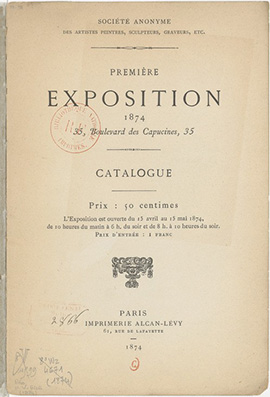
Poster & Exhibition catalogue
Examples from the exhibition
The numbers listed in the 1874 catalog are placed before the image title below. The art techniques or descriptions specified in detail in the catalogue are also listed.
The image titles correspond to those in the 1874 catalog. (Today, some titles are different.)
The provenance information lists those research sources
that provide reliable evidence for the respective work in the exhibition.
• = The sources for the 1876 exhibition suggest a possibility or assumption
that the painting may have been shown in the exhibition.
> Moffett = Charles S. Moffett: The New Painting, 1974
Catalogue with details of exhibited works in 1874
> Berson = Ruth Berson: The New Painting, 1996 (Volume 2)
Presentation of documented works exhibited in 1874
> Museum = Information in the collections and research by museums and
current art presentations on the exhibition history of a work
> Catalogue Raisonné = Artist's catalogue raisonné with exhibition details
> Newspaper reports 1874 = Ruth Berson: The New Painting, 1996 (Volume 1):
Related reports in (mostly) Parisian newspapers in 1874 on the exhibition
The exhibition was still organised under the heading "Realism". There was a painting by Monet in the exhibition, which he renamed at the last moment because people mocked his unimaginative titles. He gave it the name: "Impression - Sunrise".

Claude Monet: No. 98 - Impression, Soleil levant.
1872 - 48 x 63 cm - Oil on canvas
Musée Marmottan, Paris, France >
This painting was shown again at the 4th exhibition in 1879
Provenance: Moffett/Berson/Museum (Expo 2024: Musée d'Orsay)/Catalogue Raisonné - Wildenstein Monet Vol II Nr. 263/Newspaper reports from 1874
The satirical magazine "Le Charivari" published an article by Louis Leroy in which he made fun of practically all the artists in the exhibition. He wrote about Monet's painting: "Impression - that's what I thought. I just said to myself, since I am an impressionist, it must also be an impression and what freedom, what lightness of craft! A wallpaper in its embryonic state is more elaborate than this seascape!" (25 April 1874, Louis Leroy in Le Charivari: L'Exposition des impressionnistes)
"Impression", the word that Leroy had used as a nickname, was also subsequently adopted by objective critics. Castagnary, a friend of Édouard Manet and open to the new art, wrote: "If one wanted to characterise their intention with one word, one would have to create the new term "Impressionists"." (29 April 1874, in Le Siecle: "Exposition du boulevard de Capucines: Les Impressionnistes)
Over the years, the term 'Impressionism', which on the one hand was intended as a disparaging term of abuse, but on the other hand was used in the press and by critics both objectively and favourably, became a respected designation and is used today for one of the greatest artistic epochs in European painting.A sales event in January before the first exhibition in 1874 had realised quite good prices of between 500 and 950 francs for the artists. The expectation was therefore for a successful exhibition with a few sales that would also cover the costs of the exhibition.
Here are examples from the first Impressionist exhibition in 1874.
Paul Cézanne
Paul Cézanne, who had to be painstakingly persuaded to take part in the exhibition, only contributed three paintings. Nevertheless, he was one of the few to sell one of his paintings (The House of the Hanged Man) for around 300 francs.
Camille Pissarro - Portrait Cézanne 1874 -
National Gallery, London, United Kingdom
3 pictures in the catalogue
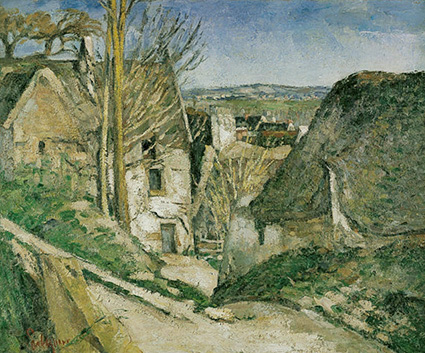
No. 42 - La Maison du Pendu, à Auvers-sur-Oise.
1873 - 55 x 66 cm - Oil on canvas
Musée d'Orsay, Paris, France >
Provenance: Moffett/Berson/Museum (Expo 2024: Musée d'Orsay)/Catalogue Raisonné - Cézanne Nr. 81/Newspaper reports from 1874
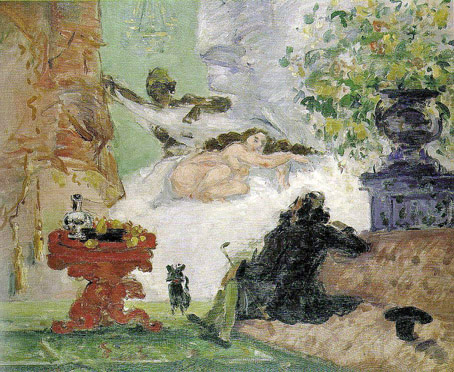
No. 43 - Une moderne Olympia. Esquisse.
1873/74 - 46 x 55 cm - Oil sketch on canvas
Musée d'Orsay, Paris, France >
Provenance: Moffett/Berson/Museum (Expo2024: Musée d'Orsay)/Catalogue Raisonné - Cézanne Nr. 628/Newspaper reports from 1874
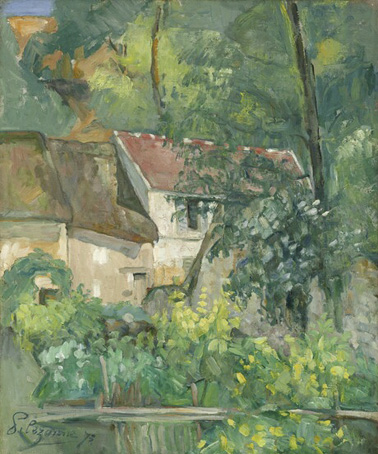
No. 44 - Étude: Paysage à Auvers.
1873 - 61 x 51 cm - Oil on canvas
National Gallery of Art, Washington, USA >
Provenance: Moffett/Berson/Museum (Expo 2024: Musée d'Orsay)/Catalogue Raisonné - Cézanne Nr. 77
Edgar Degas
Degas, whose full name was Edgar Germain Hilaire de Gas, took part in all but one of the Impressionists' exhibitions, although he himself did not want to subscribe to their views on the new painting, as he did not think much of painters "who paint on country lanes". He very much disliked the term Impressionism and always knew how to prevent it from appearing in exhibition titles. He created his paintings from sketches and motifs, which he then carefully worked out in the studio.
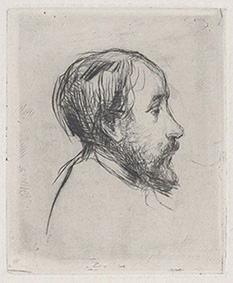
Marcellin Desboutin - Portrait Edgar Degas 1876 -
Drypoint
10 pictures in catalogue
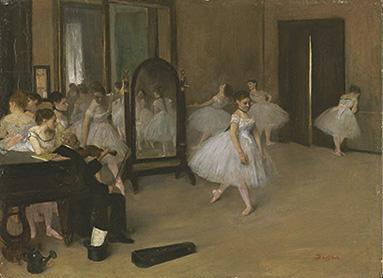
No. 55 - Classe de danse.
ca. 1870 - 19,7 x 27 cm - Oil on wooden panel
Metropolitan Museum of Art, New York, USA >
Provenance: Moffett/Berson/Museum (Expo 2024: Musée d'Orsay)/Catalogue Raisonné Edgar Degas/Newspaper reports from 1874

No. 60 - Répétition de ballet sur la scène. Dessin.
1874 - 65 x 81 cm - Oil design on canvas (grisaille)
Musée d'Orsay, Paris, France >
Provenance: Berson/Museum (Expo2024: Musée d'Orsay)/Catalogue Raisonné Edgar Degas/Newspaper reports from 1874
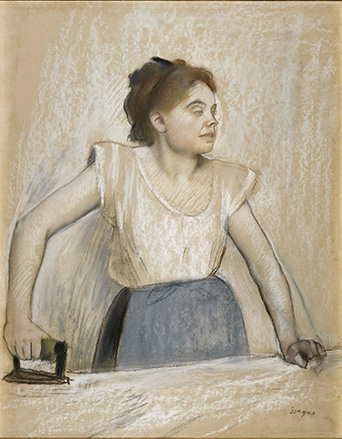
No. 61 - Une Blanchisseuse. Pastel.
ca. 1869 - 74 x 61 cm - Charcoal, white chalk and pastel on paper
Musée d'Orsay, Paris, France >
Provenance: Moffett/Berson/Museum (Expo 2024: Musée d'Orsay)/Newspaper reports from 1874
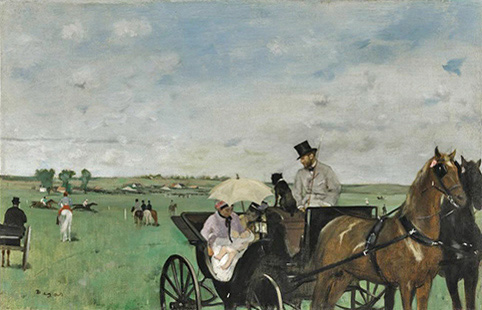
No. 63 - Aux Courses en province.
1869 - 37 x 56 cm - Oil on canvas
Museum of Fine Arts, Boston, USA >
Provenance: Moffett/Berson/Museum (Expo 2024: Musée d'Orsay)/Catalogue Raisonné Edgar Degas/Newspaper reports from 1874
Claude Monet
Claude Monet had supplied far too many pictures. It also annoyed the others that the titles of the pictures were rather unimaginative. So he added another name to the respective place. The picture that led to the name of the Impressionists (Impression - Sunrise) was originally just called "Le Havre". There was also "Le Havre, fishing boats leaving the harbour", shown below, with the same title.

Auguste Renoir - Portrait Claude Monet 1872 -
National Gallery of Art, San Francisco, USA
9 pictures in the catalogue
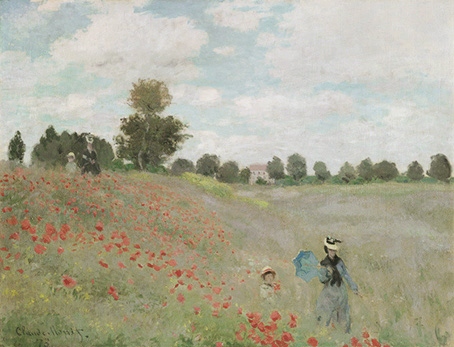
No. 95 - Coquelicots.
1873 - 50 x 65 cm - Oil on canvas
Musée d'Orsay, Paris, France >
Provenance: Moffett/Berson/Museum (Expo 2024: Musée d'Orsay)/Catalogue Raisonné - Wildenstein Monet Vol II Nr. 174/Newspaper reports from 1874
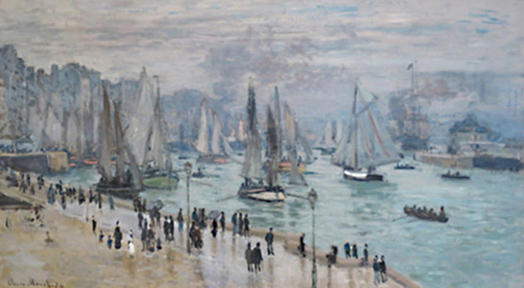
No. 96 - Le Havre: Bateaux de pêche sortant du port.
1874 - 60 x 101 cm - Oil on canvas
Private collection
Provenance: Moffett/Berson/Museum (Expo 2024: Musée d'Orsay)/Catalogue Raisonné - Wildenstein Monet Vol II Nr. 296/Newspaper reports from 1874

No. 97 - Boulevard des Capucines.
1873 - 61 х 80 cm - Oil on canvas
Puschkin-Museum, Moskau, Russia
Provenance: Moffett/Berson/Museum (Expo 2024: Musée d'Orsay)/Catalogue Raisonné - Wildenstein Monet Vol II Nr. 292/Newspaper reports from 1874
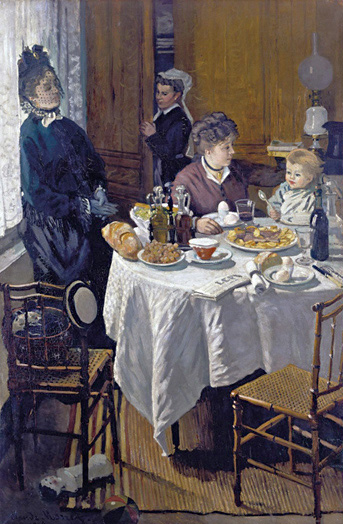
No. 103 - Déjeuner.
1868 - 231 x 151 cm - Oil on canvas
Städel Museum, Frankfurt am Main, Germany >
Provenance: Moffett/Berson/Museum (Expo 2024: Musée d'Orsay)/Catalogue Raisonné - Wildenstein Monet Vol II Nr. 132/Newspaper reports from 1874
Berthe Morisot
Berthe Morisot was the first female member of the Impressionist group. Her typical motifs included portraits of women and children, interiors and coastal landscapes. As with her male colleagues, a few judgements of her painting in the exhibition were devastating, but there were many other voices that positively emphasised the originality of her works.
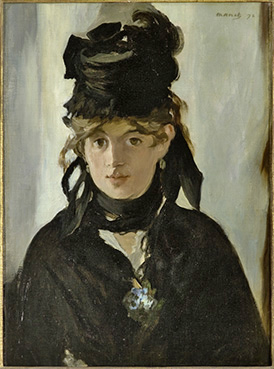
Edouard Manet: Berthe Morisot au bouquet de violettes 1872
Musée d'Orsay, Paris, France
9 pictures in the catalogue (1 except catalogue)
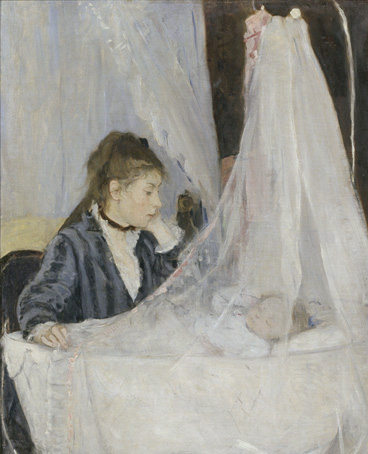
No. 104 - Le Berceau.
1872 - 56 x 46 cm - Oil on canvas
Musée d'Orsay, Paris, France >
Provenance: Moffett/Berson/Museum (Expo 2024: Musée d'Orsay)/Catalogue Raisonné - Wildenstein Morisot Nr. 25/Newspaper reports from 1874
Nr. 105 - La Lecture.
1873 - 46 x 72 cm - Oil on canvas
Cleveland Museum of Art, USA >
Provenienz: Moffett/Museum (Expo 2024: Musée d'Orsay)/Newspaper reports from 1874
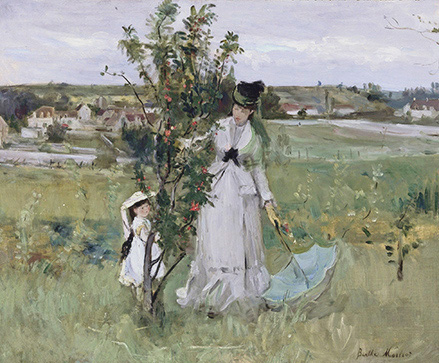
No. 106 - Cache-Cache.
1873 - 45 x 55 cm - Oil on canvas
Private collection
Provenance: Moffett/Berson/Sotheby's/Museum (Expo 2024: Musée d'Orsay)/Catalogue Raisonné - Wildenstein Morisot Nr. 27/Newspaper reports from 1874
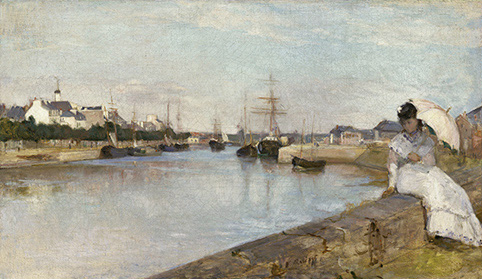
No. 107 - Marine.
1869 - 43,5 x 73 cm - Oil on canvas
National Gallery of Art, Washington, USA >
Provenance: Moffett/Berson/Museum (Expo2024: Musée d'Orsay)/Newspaper reports from 1874
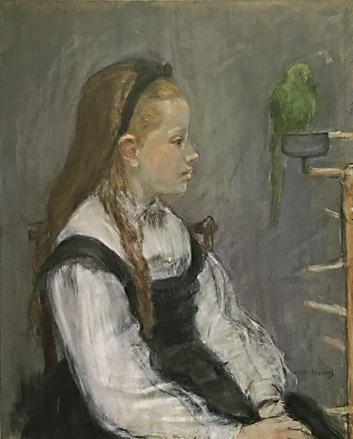
No. 108 - Portrait de Mademoiselle M. T. Pastel.
ca. 1873 - 60 x 49 cm - Pastel on paper
Private collection
Provenance: Moffett/Berson/Catalogue Raisonné - Wildenstein Morisot Nr. 426/Newspaper reports from 1874
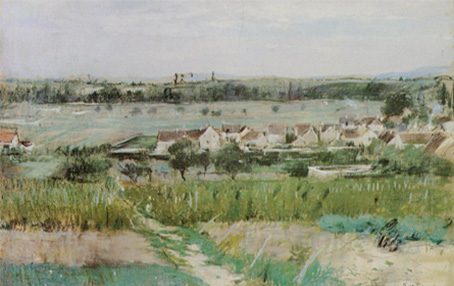
No. 109 - Un Village. Pastel.
1873 - 47 x 72 cm - Pastel on paper
Private collection
Provenance: Moffett/Berson/Catalogue Raisonné - Wildenstein Morisot Nr. 424
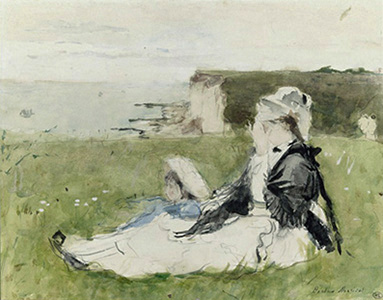
No. 110 - Sur la Falaise. Aquarelle.
1873 - 18 x 23 cm - Watercolour/gouache and pencil on paper
Musée d'Orsay, Paris, France >
Provenance: Moffett/Berson/Museum (Expo 2024: Musée d'Orsay)/Catalogue Raisonné - Wildenstein Morisot Nr. 622/Newspaper reports from 1874

No. 111 - Dans le Bois. Aquarelle.
1873/74 - 33 x 23 cm - Watercolour
Musée d'Orsay, Paris, France >
Provenance: Moffett/Berson/Museum (Expo 2024: Musée d'Orsay)/Catalogue Raisonné - Wildenstein Morisot Nr. 620
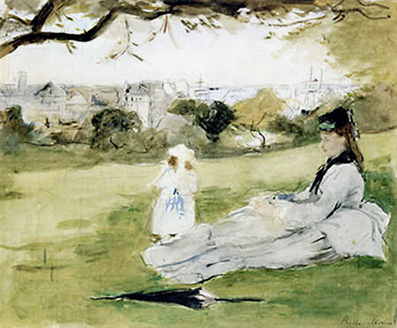
No. 112 - ........... Aquarelle.
1873/74 - 21 x 24,1cm - Watercolour
Private collection
Provenance: Moffett/Berson/Catalogue Raisonné - Wildenstein Morisot Nr. 615/Newspaper reports from 1874
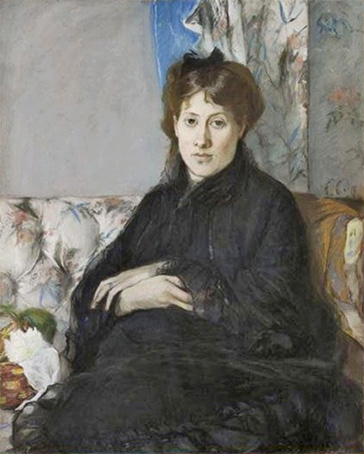
(except catalogue) hc. - Portrait Madame Edma Pontillon
1871 - 81 x 66 cm - Pastel
Musée d'Orsay, Paris, France >
Provenance: Berson/Museum (Expo2024: Musée d'Orsay)/Newspaper reports from 1874
Camille Pissarro
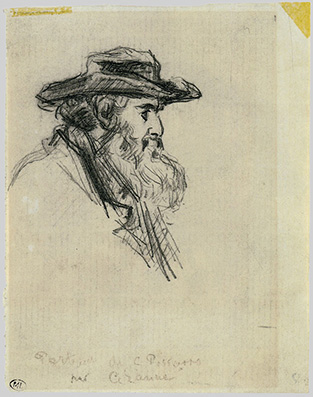
Paul Cézanne: Portrait Camille Pissarro ca. 1873
5 pictures in the catalogue
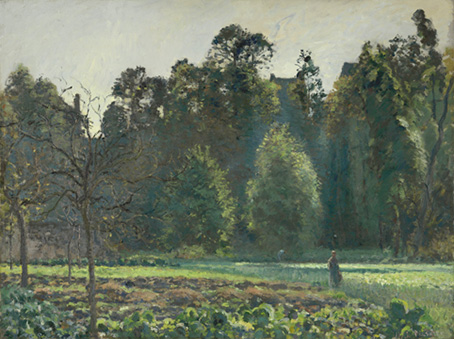
No. 136 - Le Verger.
1873 - 60 x 80 cm - Oil on canvas
Museo Thyssen-Bornemisza, Madrid, Spain >
Provenance: Museum/Catalogue Raisonné - Wildenstein: Pissarro Vol II Nr 294
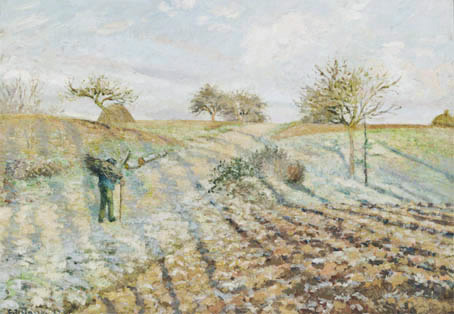
No.. 137 - Gelée blanche.
1873 - 65 x 93 cm - Oil on canvas
Musée d'Orsay, Paris, France >
Provenance: Moffett/Berson/Museum (Expo 2024: Musée d'Orsay)/Catalogue Raisonné - Wildenstein: Pissarro Vol II Nr 285/Newspaper reports from 1874
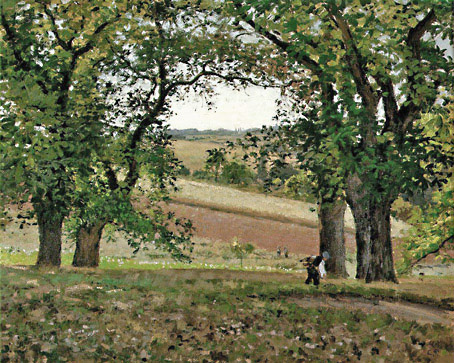
No. 138 - Les Chataigners à Osny.
1873 - 65 x 81 cm - Oil on canvas
Privat Collection
Provenance: Moffett/Berson/Museum (Expo2024: Musée d'Orsay)/Catalogue Raisonné - Wildenstein: Pissarro Vol II Nr 313/Newspaper reports from 1874
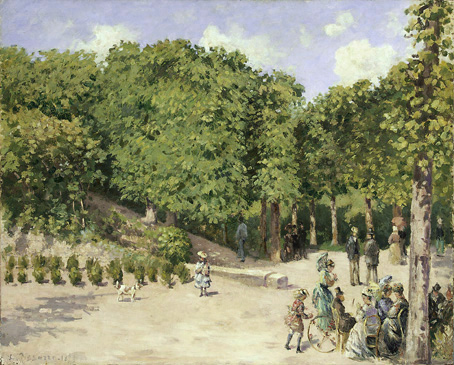
• No. 139 - Jardin de la ville de Pontoise.
1873 - 59 x 73 cm - Oil on canvas
Hermitage Museum, St. Petersburg, Russia
• Provenance: Moffett/Berson/Catalogue Raisonné - Wildenstein: Pissarro Vol II Nr 309
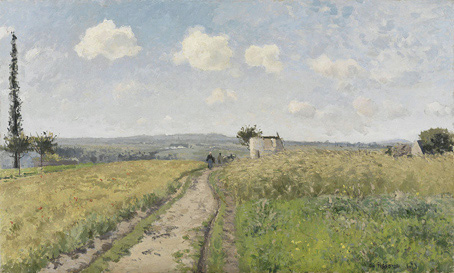
No. 140 - Un Matinée du mois de juin.
1873 - 55 x 91 cm - Oil on canvas
Staatliche Kunsthalle, Karlsruhe, Germany >
Provenance: Moffett/Berson/Museum (Expo 2024: Musée d'Orsay)/Catalogue Raisonné - Wildenstein: Pissarro Vol II Nr 312/Newspaper reports from 1874
Auguste Renoir
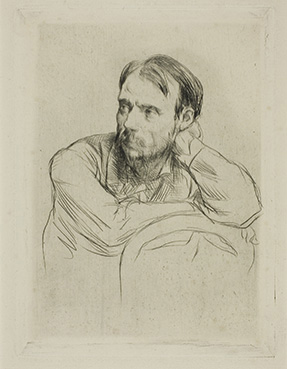
Desboutin: Portrait Renoir ca. 1877
7 pictures in the catlaogue

No. 141 - Danseuse.
1874 - 143 x 94 cm - Oil on canvas
National Gallery of Art, Washington, USA >
Provenance: Moffett/Berson/Museum (Expo 2024: Musée d'Orsay)/Catalogue raisonné: Fezzi: Pierre-Auguste Renoir, 1972 Nr. 126/Newspaper reports from 1874
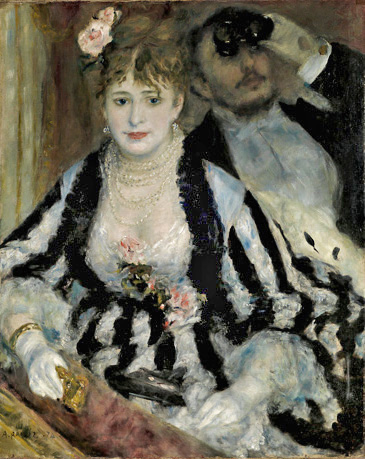
No. 142 - La Loge.
1874 - 80 x 63 cm - Oil on canvas
The Courtauld Gallery, London, United Kingdom >
Provenance: Moffett/Berson/Museum (Expo 2024: Musée d'Orsay)/Catalogue raisonné: Fezzi: Pierre-Auguste Renoir, 1972 Nr. 125/Newspaper reports from 1874
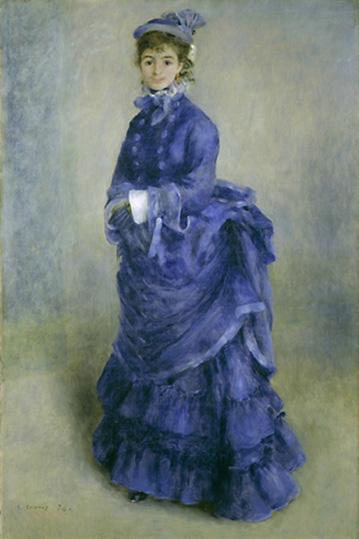
No. 143 - Parisienne.
1874 - 163 x 108 cm - Oil on canvas
National Museum of Wales, Cardiff, United Kingdom >
Provenance: Moffett/Berson/Museum (Expo2024: Musée d'Orsay)/Catalogue raisonné: Fezzi: Pierre-Auguste Renoir, 1972 Nr. 126/Newspaper reports from 1874

No. 144 - Moissonneurs.
1873 - 58 x 72 cm - Oil on canvas
Private collection
Provenance: Moffett/Berson/Catalogue raisonné: Fezzi: Pierre-Auguste Renoir, 1972 Nr. 100/Newspaper reports from 1874
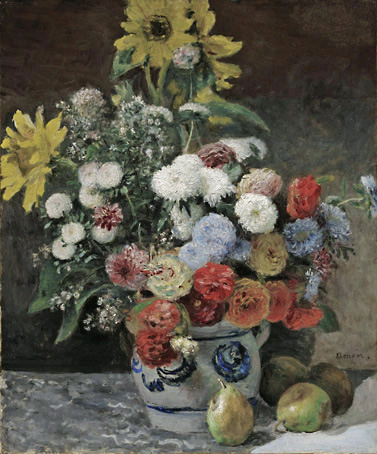
• No. 145 - Fleurs.
ca. 1869 - 65 x 54 cm - Oil on cardboard (mounted on canvas)
Museum of Fine Arts, Boston, USA >
Provenance: Moffett/Berson/Museum (Expo 2024: Musée d'Orsay)/Catalogue raisonné: Fezzi: Pierre-Auguste Renoir, 1972 Nr. 36/Newspaper reports from 1874
Alfred Sisley
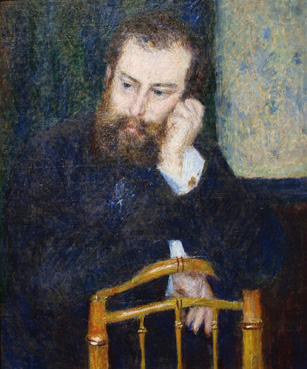
Pierre-Auguste Renoir - Portrait Alfred Sisley - 1870/76
Art Institute Chicago, USA
5 pictures in the catalogue (1 except catalogue)
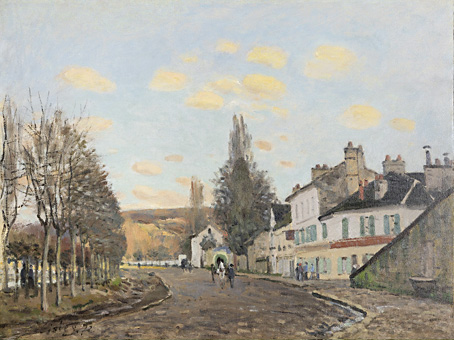
No. 161 - Route de Saint-Germain.
1872 - 46 x 61 cm - Oil on canvas
McNay Art Museum, San Antonio, USA >
Provenance: Moffett/Berson/Museum (Expo2024: Musée d'Orsay)/Catalogue raisonné Daulte: Sisley 1959 Nr. 43/Newspaper reports from 1874
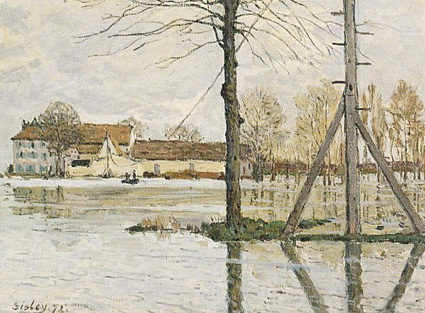
No. 162 - Île de la Loge.
1872 - 45 x 60 cm - Oil on canvas
Ny Carlsberg Glyptotek, Copenhagen Denmark
Provenance: Moffett/Berson/Museum (Expo 2024: Musée d'Orsay)/Catalogue raisonné Daulte: Sisley 1959 Nr. 21/Newspaper reports from 1874

No. 163 - La Seine à Port-Marly.
1873 - 43 x 65 cm - Oil on canvas
Ny Carlsberg Glyptotek, Copenhagen, Denmark
Provenance: Moffett/Berson/Museum (Expo 2024: Musée d'Orsay)/Catalogue raisonné Daulte: Sisley 1959 Nr. 67/Newspaper reports from 1874
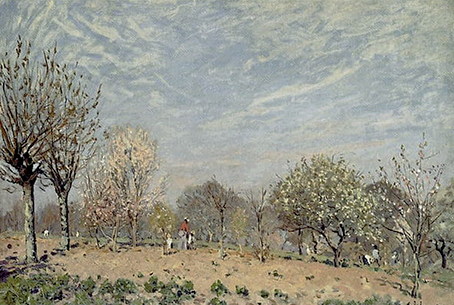
Nr. 164 - Verger.
1873 - 51 x 73 cm - Oil on canvas
Private collection
Provenance: Moffett/Berson/Museum (Expo 2024: Musée d'Orsay)/Catalogue raisonné Daulte: Sisley 1959 Nr. 62/Newspaper reports from 1874
Nr. 165 - Port Marly, soirée d'hiver
1872 - 47 x 66 cm - Oil on canvas
Palais des Beaux-Arts, Lille, France >
• Provenance: Museum (Expo2024: Musée d'Orsay)/Catalogue raisonné Daulte: Sisley 1959 Nr. 45
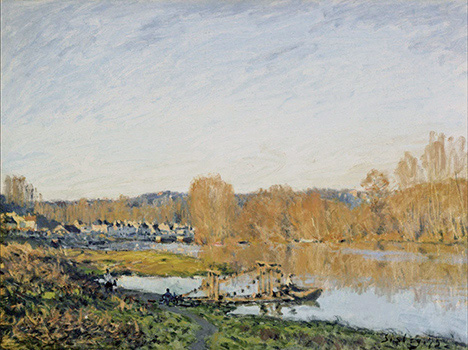
(Except catalog) hc. - L’Automne, bords de la Seine près Bougival
1873 - 46 x 62 cm - Oil on canvas
Montreal Museum of Fine Arts, Montreal, Canada >
Provenance: Moffett/Berson/Museum/Catalogue raisonné Daulte: Sisley 1959 Nr. 94/Newspaper reports from 1874
Other artists who contributed to the exhibition:
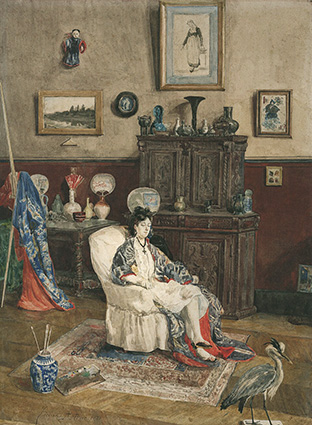
• Zacharie Astruc: Nr. 33 2 - Cadre de figures contenant: Scène de Somnambulisme. Aquarelle.
ca. 1871 - 42 x 56 cm - Watercolour
Fonds Musée de l'Opera, Vichy, France
Provenance: Museum (Expo2024: Musée d'Orsay)/Newspaper reports from 1874
Nr. 3 4 - Cadre de figures contenant - Poupées japonaises. Aquarelle.
ca. 1871 - 37 x 27 cm - Watercolour on paper, mounted on canvas
Private collection
Provenance: • Berson/Museum (Expo2024: Musée d'Orsay))/Newspaper reports from 1874
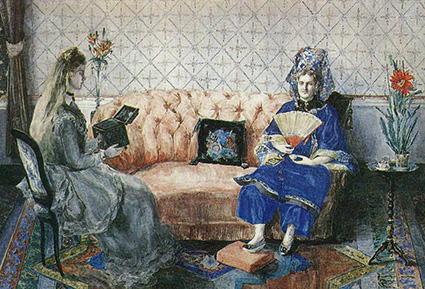
Zacharie Astruc: No. 3 5 - Cadre de figures contenant: Les Présents chinois (Londres). Aquarelle.
ca. 1873 - 38 x 55 cm - Watercolour
Private collection
Provenance: Berson/Museum (Expo2024: Musée d'Orsay)/Newspaper reports from 1874
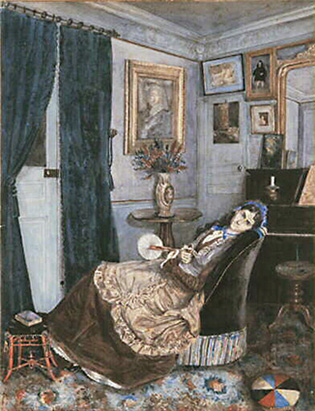
Zacharie Astruc: No. 3 6 - Cadre de figures contenant: Intérieur parisien. Aquarelle.
1874 - 36,4 x 28,4 cm - Watercolour
Musée d’Evreux, Evreux, France
Provenance: Moffett/Berson/Museum (Expo2024: Musée d'Orsay)/Newspaper reports from 1874
Antoine-Ferdinand Atendu: No. 7 - Nature morte.
ca. 1874 - 66 x 92 cm - Pastel on paper mounted on canvas
Musée d'Art et d'Archéologie, Valence, France
Provenance: Museum (Expo2024: Musée d'Orsay)
Édouard Béliard: Nr. 15 - Rue de de l'Hermtage, à Pontoise.
ca. 1872 - 38 x 65 cm - Oil on canvas
Musée d'art et d'histore Pissarro, Pontoise, France
• Provenance: Museum (Expo2024: Musée d'Orsay)
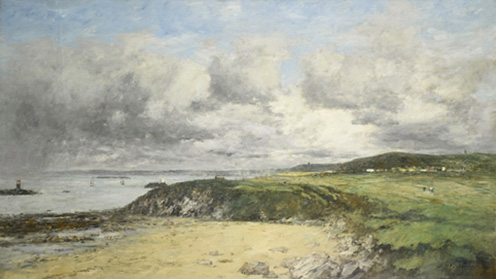
Eugène Boudin: No. 18/19 - Rivage de Portrieux (Côtes-du-Nord).
1874 - 86 x 150 cm - Oil on canvas
Private collection
• Provenance: Moffett/Berson
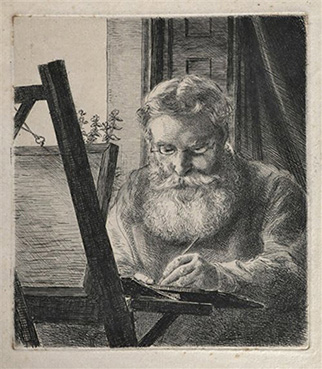
Félix Bracquemond: No. 24 4 - Cadre d'eaux-fortes: Portrait de MM. Edwards.
1872 - 16,2 x14,6 cm - Etching
Provenance: Moffett/Berson/Museum (Expo2024: Musée d'Orsay)
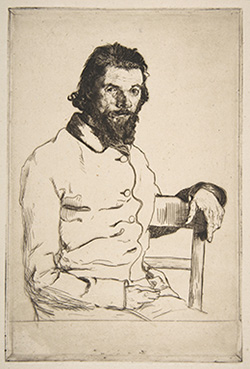
Félix Bracquemond: No. 24 8 - Cadre d’eaux-fortes: Portrait de M.M. Meryon.
1853 - 12 × 8,8 cm - Etching
Provenance: Moffett/Berson
Félix Bracquemond: Nr. 25 1 - Cadre d’eaux-fortes: La Locomotive.
D'après Turner. (Planche non terminée).
1853 - 21,7 x 26,1 cm - Etching
Provenienz: Moffett/Berson/Museum (Expo2024: Musée d'Orsay)
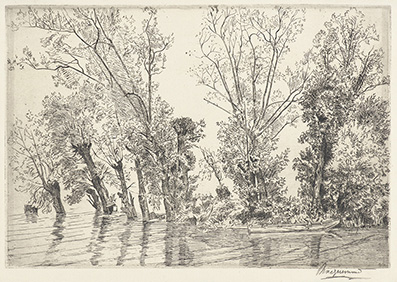
Félix Bracquemond: No. 26 1 - Cadre d’eaux-fortes: Les Saules.
1868 - 20,2 × 29,4 cm - Etching
Provenance: Moffett/Berson
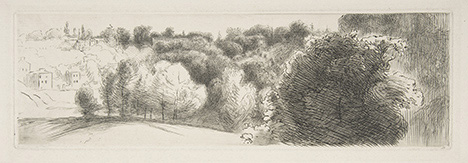
Félix Bracquemond: No. 26 5 - Cadre d'eaux-fortes: La Montée de Bellevue.
1873 - 9.9 × 31,8 cm - Drypoint
Provenance: Moffett/Berson/Museum (Expo2024: Musée d'Orsay)
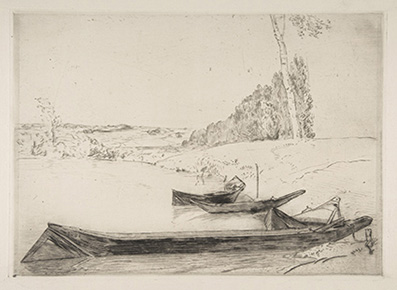
Félix Bracquemond: No. 26 7 - Cadre d'eaux-fortes: Les Bachots. Pointe sèche
1858 - 25 x 34,9 cm - Drypoint
Provenance: Moffett/Berson
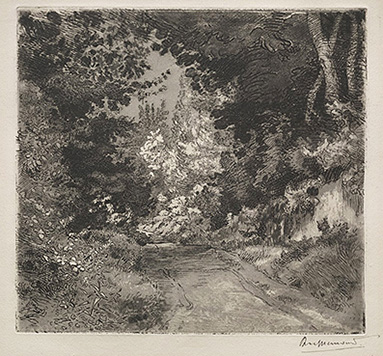
Félix Bracquemond: No. 27 1 - Cadre d’eaux-fortes: Le Chemin du parc.
ca. 1872 - 21,5 x 23,1 cm - Etching and aquatint
Provenance: Moffett/Berson
Félix Bracquemond: Nr. 27 5 - Cadre d’eaux-fortes: Le Mort de Matamore (Capitane Fracasse).
ca. 1861 - 16 x 22,5 cm - Etching
Provenance: Moffett/Berson

Edouard Brandon: Nr. 29 - Premiére Lecture de la Loi.
Vor 1869 - 36,5 x 45,5 cm - Oil on canvas
Musée d'art et d'historice du Judaisme, Paris, France
• Provenance: Berson/Museum (Expo2024: Musée d'Orsay)/Newspaper reports from 1874
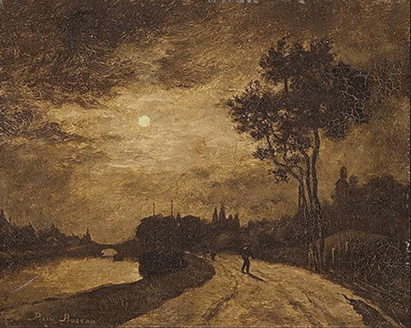
Pierre-Isodore Bureau: No. 35 - Bords de l’Oise (Isle-Adam), Clair-de-Lune.
Um 1867 - 33 x 41 cm - Oil on canvas
Musée d’Orsay, Paris, France >
• Provenance: Moffett/Berson/Museum (Expo2024: Musée d'Orsay)/Newspaper reports from 1874
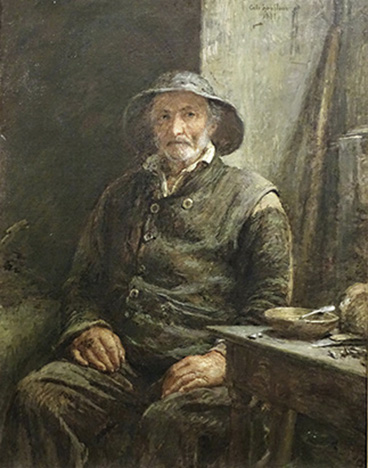
Adolphe-Felix Cals: No. 38 - Vieux Pêcheur.
1873 - 116 x 89 cm - Oil on canvas
Musée Eugène-Boudin de Honfleur, France
Provenance: Moffett/Berson/Catalogue Raisonné - A.-F. Cals
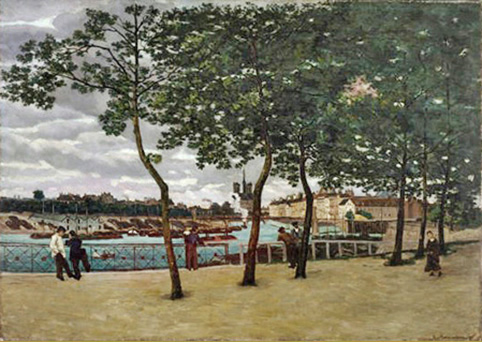
Jean-Baptiste Guillaumin: No. 65 - Temps pluvieux. Paysage.
1871 - 126 × 181 cm - Oil on canvas
The Museum of Fine Arts, Houston, USA >
Provenance: Moffett/• Berson/Newspaper reports from 1874
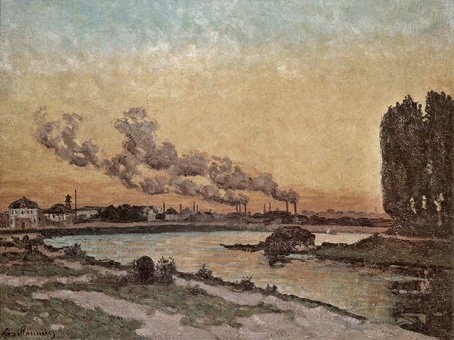
Jean-Baptiste Guillaumin: No. 66 - Soleil couchant à Ivry.
1873 - 65 x 81 cm - Oil on canvas
Musée d´Orsay, Paris, France >
Provenance: Moffett/Berson/Museum (Expo 2024: Musée d'Orsay)
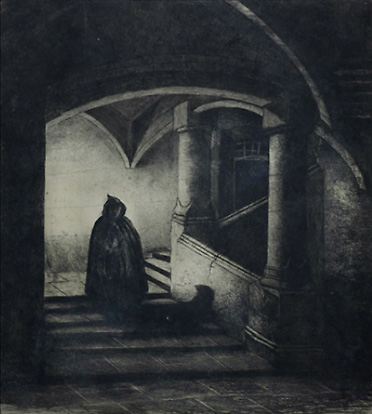
Ludovic Napoléon Lepic: No. 78 - L'Escalier du château d'Aix en Savoie. Eau-forte.
1863 - 41 x 38,4 cm - Etching
Provenance: Moffett/Berson
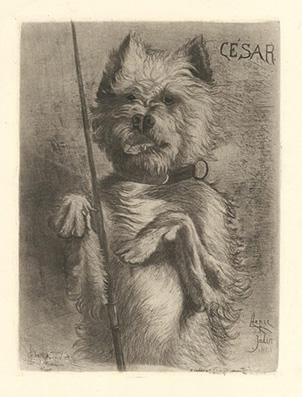
Ludovic Napoléon Lepic: No. 79 - César. Portrait de chien. Eau-forte.
1861 - 32,5 x 24 cm - Etching and roulette
Provenance: Moffett/Berson/Museum (Expo2024: Musée d'Orsay)
Stanisilas Lepine - Nr. 82 - La Rue Cortot.
ca. 1871/72 - 56 x 38 cm - Oil on canvas
Privat Collection
Provenienz: • Berson/Museum (Expo2024: Musée d'Orsay)/Zeitungsbericht
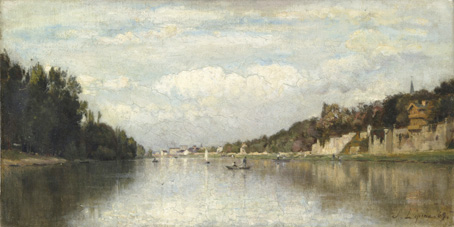
Stanislas Lepine: No. 83 - Bords de la Seine.
1869 - 30 x 59 cm - Oil on canvas
Musée d’Orsay, Paris, France >
Provenance: Moffett/Berson/Museum (Expo2024: Musée d'Orsay)/Newspaper reports from 1874

Auguste de Molins: No. 92 - The Coming Storm.
1874 - 35 x 55 cm - Oil on canvas
Privat Collection
Provenance: Moffett/Berson
Auguste de Molins: Nr. 93 - Rendez-vouz de chasse
1874 - 35 x 56 cm - Öl auf Leinwand
Privatbesitz
• Provenienz: Berson/Museum (Expo2024: Musée d'Orsay)
Auguste de Molins: Nr. 94bis - Rende-vouz de chasse
1874 - 34 x 55 cm - ÖL auf Leinwand
Privatbesitz
• Provenienz: Moffett/Museum (Expo2024: Musée d'Orsay)
Guiseppe de Nittis: Nr. 117 - Campagne de Vésuve.
1872 - 13,5 x 17,5 cm - Öl auf Lenwand
Galleria d'Arte Moderna, Milano, Italy
Provenance: Moffett/Museum (Musée d'Orsay)/Newspaper reports from 1874
Guiseppe de Nittis: Nr. 118bis - Route en Italiy.
1870 - 43 x 65 cm - Öl auf Leinwand
Pinakoteka Giuseppe de Nittis, Barletta, Itlay
Provenance: Moffett/Museum (Musée d'Orsay)/Newspaper reports from 1874
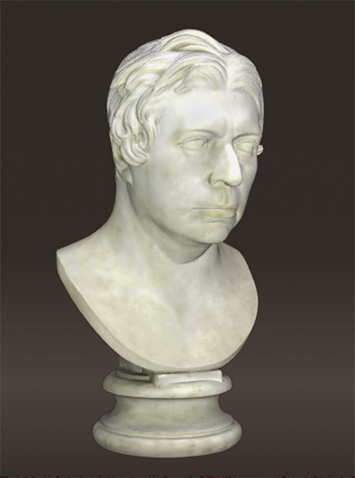
Auguste-Louis-Marie Ottin: No. 126 - Buste de Ingres. Réduction en plàtre.
1840 - High 52,5 cm - Plaster cast
Musée Ingres Bourdelle, Montauban, France >
Provenance: Moffett/Berson/Newspaper reports from 1874
Attempt to depict the exhibition rooms in Nadar's studio in 1874.
Based on models from an exhibition at the Musée d'Orsay, Paris, in 2024.
(„Paris 1874 - Inventer l’Impressionisme“)
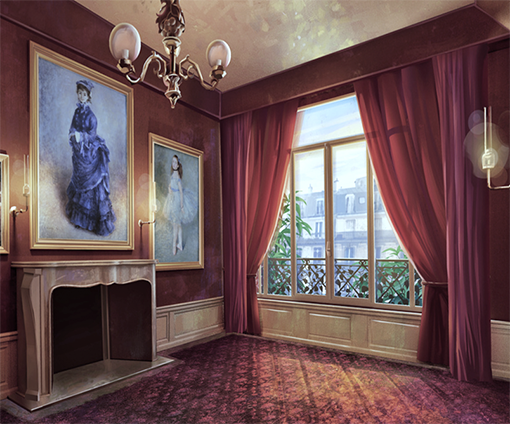
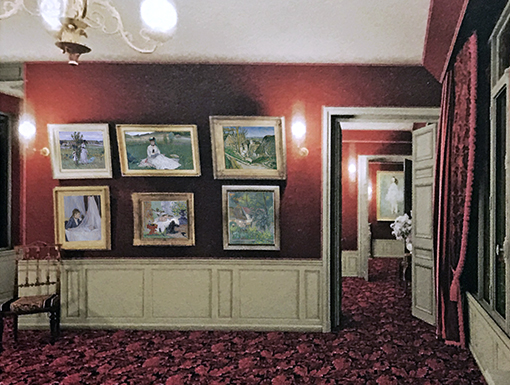
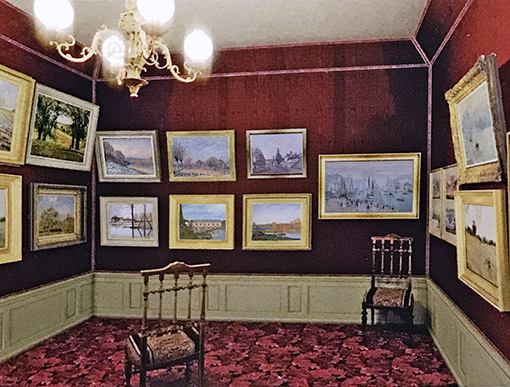
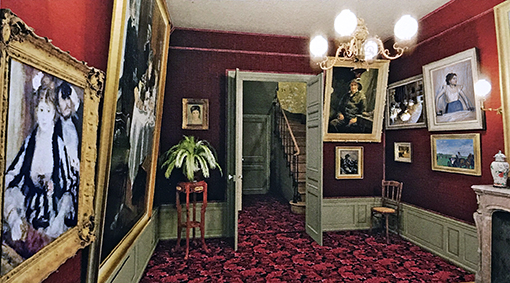
The number of visitors was not as expected. Around 3500 people came over the four weeks (in comparison: the Salon of the same year had 400,000 visitors, who were able to view around 4000 works of art).
It is said that some visitors had only come to amuse themselves. A few scathing reviews among the many favourable reports of the 50 or so publications on the exhibition in the newspapers probably also contributed to this. As late as 1877, F. O'Squirre recalled in the Courier de France: "The public conscience was outraged!" he wrote and continued: "It was appalling, foolish, mean; this painting is worthless!" That was more of an individual opinion, because overall the reception by the audience and the press was rather positive and interested about the new development.
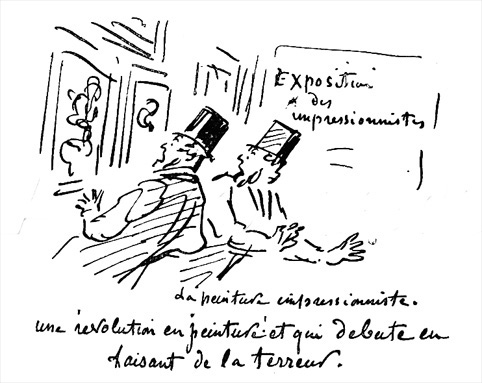
Caricature of Cham (1874, Le Cahrivari)
Amédée Charles Henri de Noé - Artist name Cham
"Exhibition of the Impressionists:
Impressionist Painting, a revolution in painting,
that begins with terror"
"The critics are eating us alive", wrote Pissarro in a very exaggerated manner in a letter to a friend in 1874. In reality, the idea that all critics were against the Impressionists is something of a myth. Many critics were neutral but open to the new. And there were also quite favourable reviews, even if their praise was sometimes limited. For example, it began with encouraging words: "Bathed in bright light, everything is cheerfulness, clarity, like spring festivals, golden evenings or blossoming apple trees. Her not-too-large paintings seem to be windows ... that reveal the enchanting life outside." However, the critic added: "They do not choose their motifs with the care of earlier landscape painters..." (Armand Silvestre: "Chronique des beaux-arts: Physiolgie du refusé - L'Expositon des révoltés" in 'L'opinion nationale' on 22 April 1874)
There were too few people interested in buying pictures. As a result, the costs of the exhibition did not develop as desired. According to the final accounts, there were outstanding debts of over 3700 francs despite the income of around 10,000 francs. It seemed to the painters involved that the right course of action was to dissolve the artists' society. Renoir, Sisley and Bureau were responsible for the liquidation.
The term "Impressionism" was soon accepted by some of the painters in the group as a coherent description of their work and thus they gave this word a real meaning.
Their aim was to come closer to the appearance of things in form and expression than had ever been achieved before. They freed themselves from tradition and continued to develop their style. It allowed them to follow their discoveries and their feelings. They renounced the claim of reproducing reality; only one element of reality counted: light! Renoir once said about painting: "Outdoors, you're always cheating!" Whereby this "cheating" essentially consisted of selecting one of a multitude of moments in nature and reproducing it in colours and painting style in such a way that it came close to one's own impression.
"The general public was not yet ready to embrace such innovations. Since the time of their teachers Courbet and Corot, as well as the painters of Barbizon, they had made great progress. Despite all the attacks, they did not give up their convictions. The Impressionists continued their creative work, like an acting troupe playing to an empty theatre every night. ..." (John Rewald)
